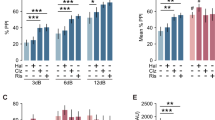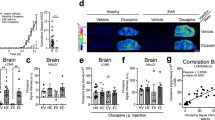Abstract
Despite substantial differences between species in the organization and elaboration of the cortical dopamine innervation, little is known about the pharmacological response of cortical or striatal sites to antipsychotic medications in nonhuman primates. To examine this issue, rhesus monkeys were chronically implanted with guide cannulae directed at the principal sulcus, medial prefrontal cortex, premotor cortex, and caudate nucleus. Alterations in dopamine release in these discrete brain regions were measured in response to administration of clozapine or haloperidol. Clozapine produced significant and long-lasting increases in dopamine release in the principal sulcus, and to a lesser extent, in the caudate nucleus. Haloperidol did not produce a consistent effect on dopamine release in the principal sulcus, although it increased dopamine release in the caudate. Clozapine's preferential augmentation of dopamine release in the dorsolateral prefrontal cortex supports the idea that clozapine exerts its therapeutic effects in part by increasing cortical dopamine neurotransmission.
Similar content being viewed by others
Log in or create a free account to read this content
Gain free access to this article, as well as selected content from this journal and more on nature.com
or
References
Ashby CR, Jr, Wang RY . (1996): Pharmacological actions of the atypical antipsychotic drug clozapine: a review. Synapse 24: 349–394
Berger B, Casper P, Verney C . (1991): Dopaminergic innervation of the cerebral cortex: unexpected differences between rodents and primates. TINS 14: 21–27
Bourdelais AJ, Deutch AY . (1994): The effects of haloperidol and clozapine on extracellular GABA levels in the prefrontal cortex of the rat: an in vivo microdialysis study. Cereb Cortex 4: 69–77
Creese I, Burt DR, Snyder SH . (1977): Dopamine receptor binding enhancement accompanies lesion-induced behavioral supersensitivity. Science 197: 596–598
Daly DA, Moghaddam B . (1993): Actions of clozapine and haloperidol on the extracellular levels of excitatory amino acids in the prefrontal cortex and striatum of conscious rats. Neurosci Lett 152: 61–64
Davis KL, Kahn RS, Ko G, Davidson M . (1991): Dopamine in schizophrenia: a review and reconceptualization. Am J Psychiatry 148: 1474–1486
Jakab RL, Goldman-Rakic PS . (1998): 5-hydroxytryptamine(2A) serotonin receptors in the primate cerebral cortex—possible site of action of hallucinogenic and antipsychotic drugs in pyramidal cell apical dendrites. Proc Natl Acad Sci 95: 735–740
Jentsch JD, Redmond DE Jr, Elsworth JD, Taylor JR, Youngren KD, Roth RH . (1997): Enduring cognitive deficits and cortical dopamine dysfunction in monkeys after long-term administration of phencyclidine. Science 277: 953–955
Kane J, Honigfeld G, Singer J, Meltzer H . (1988): Clozapine for the treatment-resistant schizophrenic. A double-blind comparison with chlorpromazine. Arch Gen Psychiatry 45: 789–796
Kane JM, Woerner MG, Pollack S, Safferman AZ, Lieberman JA . (1993): Does clozapine cause tardive dyskinesia? J Clin Psychiatry 54: 327–330
Karreman M, Moghaddam B . (1996): The prefrontal cortex regulates the basal release of dopamine in the limbic striatum: an effect mediated by ventral tegmental area. J Neurochem 66: 589–598
Kolachana BS, Saunders RC, Weinberger DR . (1994): An improved methodology for routine in vivo microdialysis in non-human primates. J Neurosci Methods 55: 1–6
Kolachana BS, Saunders RC, Weinberger DR . (1995): Augmentation of prefrontal cortical monoaminergic activity inhibits dopamine release in the caudate nucleus: an in vivo neurochemical assessment in the rhesus monkey. Neuroscience 69: 859–868
Lee MA, Thompson PA, Meltzer HY . (1994): Effects of clozapine on cognitive function in schizophrenia. J Clin Psychiatry 55: 82–87
Lidow MS, Elsworth J, Goldman-Rakic PS . (1997): Down-regulation of the D1 and D5 dopamine receptors in the primate prefrontal cortex by chronic treatment with antipsychotic drugs. J Pharmacol Exp Ther 281: 597–603
Lidow MS, Goldman-Rakic PS . (1994): A common action of clozapine, haloperidol, and remoxipride on D1- and D2-dopaminergic receptors in the primate cerebral cortex. Proc Natl Acad Sci USA 91: 4353–4356
Machida CA, Searles RP, Nipper V, Brown JA, Kozell LB, Neve KA . (1992): Molecular cloning and expression of the rhesus macaque D1 dopamine receptor gene. Mol Pharmacol 41: 652–659
Moghaddam B, Berridge CW, Goldman-Rakic PS, Bunney BS, Roth RH . (1993): In vivo assessment of basal and drug-induced dopamine release in cortical and subcortical regions of the anesthetized primate. Synapse 13: 215–222
Moghaddam B, Bunney BS . (1990): Acute effects of typical and atypical antipsychotic drugs on the release of dopamine from prefrontal cortex, nucleus accumbens, and striatum of the rat: an in vivo microdialysis study. J Neurochem 54: 1755–1760
Mrzljak L, Bergson C, Pappy M, Huff R, Levenson R, Goldman-Rakic PS . (1996): Localization of dopamine D4 receptors in GABAergic neurons of the primate brain. Nature 381: 245–248
Pehek EA . (1996): Local infusion of the serotonin antagonists ritanserin or ICS 205,930 increases in vivo dopamine release in the rat medial prefrontal cortex. Synapse 24: 12–18
Pehek EA, Meltzer HY, Yamamoto BK . (1993): The atypical antipsychotic drug amperozide enhances rat cortical and striatal dopamine efflux. Eur J Pharmacol 240: 107–109
Preuss TM, Goldman-Rakic PS . (1991): Ipsilateral cortical connections of granular frontal cortex in the strepsirhine primate Galago, with comparative comments on anthropoid primates. J Comp Neurol 310: 507–549
Rasmusson AM, Goldstein LE, Deutch AY, Bunney BS, Roth RH . (1994): 5-HT1a agonist ±8-OH-DPAT modulates basal and stress-induced changes in medial prefrontal cortical dopamine. Synapse 18: 218–224
Rollema H, Lu Y, Schmidt AW, Zorn SH . (1997): Clozapine increases dopamine release in prefrontal cortex by 5-HT1A receptor activation. Eur J Pharmacol 338: R3–5
Saunders RC, Kolachana BS, Bachevalier J, Weinberger DR . (1998): Neonatal lesions of the medial temporal lobe disrupt prefrontal cortical regulation of striatal dopamine. Nature 393: 169–171
Schmidt CJ, Fadayel GM . (1995): The selective 5-HT2A receptor antagonist, MDL 100,907, increases dopamine efflux in the prefrontal cortex of the rat. Eur J Pharmacol 273: 273–279
Seeman P, Lee T, Chau-Wong M, Tedesco J, Wong K . (1976): Antipsychotic drug doses and neuroleptic/dopamine receptors. Nature 261: 717–719
Seeman P . (1992): Dopamine receptor sequences. Therapeutic levels of neuroleptics occupy D2 receptors, clozapine occupies D4. Neuropsychopharmacol 7: 261–284
Taber MT, Das S, Fibiger HC . (1995): Cortical regulation of subcortical dopamine release: mediation via the ventral tegmental area. J Neurochem 65: 1407–1410
Uylings HBM, van Eden CG . (1990): Qualitative and quantitative comparison of the prefrontal cortex in rat and in primates, including humans. In Uylings HBM, van Eden CG, De Bruin JPC, Corner MA, Feenstra MGP (eds), Progress in Brain Research, Vol 85. Amsterdam: Elsevier, pp 31–62
van Tol HH, Bunzow JR, Guan H-C, Sunahara RK, Seeman P, Niznik HB, Civelli O . (1991): Cloning of the gene for a human dopamine D4 receptor with high affinity for the antipsychotic clozapine. Nature 350: 610–614
Wang J, Skirboll S, Aigner TG, Saunders RC, Hsiao J, Bankiewicz KS . (1990): Methodology of microdialysis of neostriatum in hemiparkinsonian nonhuman primates. Exp Neurol 110: 181–186
Weinberger DR, Berman KF, Zec RF . (1986): Physiologic dysfunction of dorsolateral prefrontal cortex in schizophrenia. I. Regional cerebral blood flow evidence. Arch Gen Psychiatry 43: 114–124
Williams GV, Rao SG, Franowitz M, Romanski L, Goldman-Rakic PS . (1996): Ritanserin reduces activity of prefrontal pyramidal neurons recorded during working memory tasks. Soc Neurosci Abstr 22: 1936
Williams SM, Goldman-Rakic PS . (1993): Characterization of the dopaminergic innervation of the primate frontal cortex using a dopamine-specific antibody. Cereb Cortex 3: 199–222
Yamamoto BK, Cooperman MA . (1994): Differential effects of chronic antipsychotic drug treatment on extracellular glutamate and dopamine concentrations. J Neurosci 14: 4159–4166
Youngren KD, Moghaddam B, Bunney BS, Roth RH . (1994): Preferential activation of dopamine overflow in prefrontal cortex produced by chronic clozapine treatment. Neurosci Lett 165: 41–44
Acknowledgements
We thank Terri Beattie for expert technical assistance and Dr. Nicolas Hengartner (Dept. of Statistics, Yale University) for assistance in analyzing data. Support for these studies came from National Institutes of Health grants MH44866, MH48404, and MH14092.
Author information
Authors and Affiliations
Rights and permissions
About this article
Cite this article
Youngren, K., Inglis, F., Pivirotto, P. et al. Clozapine Preferentially Increases Dopamine Release in the Rhesus Monkey Prefrontal Cortex Compared with the Caudate Nucleus. Neuropsychopharmacol 20, 403–412 (1999). https://doi.org/10.1016/S0893-133X(98)00082-7
Received:
Revised:
Accepted:
Issue date:
DOI: https://doi.org/10.1016/S0893-133X(98)00082-7
Keywords
This article is cited by
-
Differential effects of d- and l-enantiomers of govadine on distinct forms of cognitive flexibility and a comparison with dopaminergic drugs
Psychopharmacology (2021)
-
The modulation of adult neuroplasticity is involved in the mood-improving actions of atypical antipsychotics in an animal model of depression
Translational Psychiatry (2017)
-
Adolescent stress leads to glutamatergic disturbance through dopaminergic abnormalities in the prefrontal cortex of genetically vulnerable mice
Psychopharmacology (2017)
-
Modulation of Limbic Circuitry Predicts Treatment Response to Antipsychotic Medication: A Functional Imaging Study in Schizophrenia
Neuropsychopharmacology (2009)
-
Molecular mechanisms underlying synergistic effects of SSRI–antipsychotic augmentation in treatment of negative symptoms in schizophrenia
Journal of Neural Transmission (2009)



